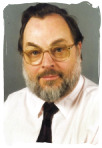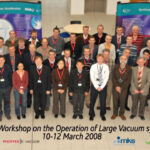26 March
Getting Behind the Wheel and onto the ILC website! Dr. Ian Bailey of Cockcroft Institute and Univ. of Liverpool, working on the ILC positron source development, getting behind the wheel and onto the ILC website. Headline photo on the ILC web and Photo of the Week on ILC Newsline. (www.linearcollider.org/newsline/) (www.linearcollider.org/cms/)
18 March
 Director Chattopadhyay accepted a gracious invitation from colleagues in Scotland and visited Glasgow on March 18, 2008 to initiate discussions on possible collaboration with the Scottish Universities Physics Association (SUPA). The Cockcroft Institute was already visited by Dr. Avril Manners in 2007 for joint collaborative programmes on Physics Education and Training in the field of Accelerators and Lasers. (left to right): Prof. Chattopadhyay, Prof.Guenther Rosner of the University of Glasgow and Prof. Dino Jaroszynski of University of Strathclyde
Director Chattopadhyay accepted a gracious invitation from colleagues in Scotland and visited Glasgow on March 18, 2008 to initiate discussions on possible collaboration with the Scottish Universities Physics Association (SUPA). The Cockcroft Institute was already visited by Dr. Avril Manners in 2007 for joint collaborative programmes on Physics Education and Training in the field of Accelerators and Lasers. (left to right): Prof. Chattopadhyay, Prof.Guenther Rosner of the University of Glasgow and Prof. Dino Jaroszynski of University of Strathclyde
 14 March
14 March
APS Outstanding Referee Dr. Desmond P. Barber, an affiliate of CI and a Visiting Professor at the University of Liverpool Physics Department has been named as an APS Outstanding Referee. [toggle_box]
[toggle_item title=”APS Outstanding Referee” active=”false”]Dear Dr. Barber,
I thank you for your help as a referee for the American Physical Society. To express our appreciation for the essential work that anonymous peer reviewers do for our journals, we are starting an annual program to recognize a small number of our 42,000 referees each year as “Outstanding Referees”.
I am pleased to inform you that the editors of the APS journals have chosen you as one of the inaugural group of 534 Outstanding Referees. We intend to choose an additional 130 or so referees each subsequent year for this lifetime award. Your reports and advice have helped to advance and diffuse the knowledge of physics, while creating a resource that is invaluable to authors, researchers, students, and readers.
Although most scientists understand that participation as a referee is necessary for maintaining the integrity of the scientific enterprise, not all have given of their time and wisdom as generously as you have. Thank you and congratulations!
You will be receiving a personalized certificate and an Outstanding Referee lapel pin by postal mail later this year.
In order for us to recognize you properly etc etc…
We thank you, again, and please know how deeply we appreciate your contributions. You are truly an outstanding referee. We shall be glad to hear from you if you have any comments or suggestions regarding this program.
Sincerely,
Gene D. Sprouse
Editor-in-Chief, American Physical Society
[/toggle_item]
[/toggle_box]
14 March
Professor Gerald Gabrielse who is a Distinguished Affililate of the Cockcroft Institute and a Visiting Profesor of Physics at the University of Liverpool has received the Tomassoni prize from Italy.[toggle_box]
[toggle_item title=”Caterina Tomassoni and Felice Pietro Chisesi prize” active=”false”]
Professor Gerald Gabrielse
(George Vasmer Leverett Professor of Physics, Harvard University)
Professor Gerald Gabrielse who is a Distinguished Affililate of the Cockcroft Institute and a Visiting Profesor of Physics at the University of Liverpool has received the Tomassoni prize from Italy.
Motivation:
For the measurement of the g-factor of the electron to an accuracy of 2.8 x 10-13 and for low energy antimatter physics, which included sensitive probes of the baryon/antibaryon asymetry and whose pioneering methods opened the way to antihydrogen production and future spectroscopy.
In particular, his measurement of the dimensionless electron magnetic moment, the electron g-value, is 15 times more accurate than the measurement performed by Hans Dehmelt twenty years earlier. Such precision opens the way to QED tests of unprecedented accuracy and allows the testing of possible finite size and composite structure of the electron, not yet detected. In addition, Gerald Gabrielse was the first to propose the use of low-energy antiprotons and methods to produce cold antihydrogen atoms that could be trapped for spectroscopic analyses. In 2002, two teams (one led by Gabrielse) produced antihydrogen during the positron cooling of antiprotons within a nested Penning trap – a method and device that Gabrielse had invented.
(reproduced from the Tomassoni Prize website)
[/toggle_item]
[/toggle_box]
 14 March
14 March
Kosmas Panagiotidis has won a prize in the annual PhD poster competition run for PhD students in the University of Liverpool. …see poster »
 11 March
11 March
OLAV II Second Workshop on the Operation of LArge Vacuum systems 10th-12th March 2008 (Click thumbnail for larger version)

